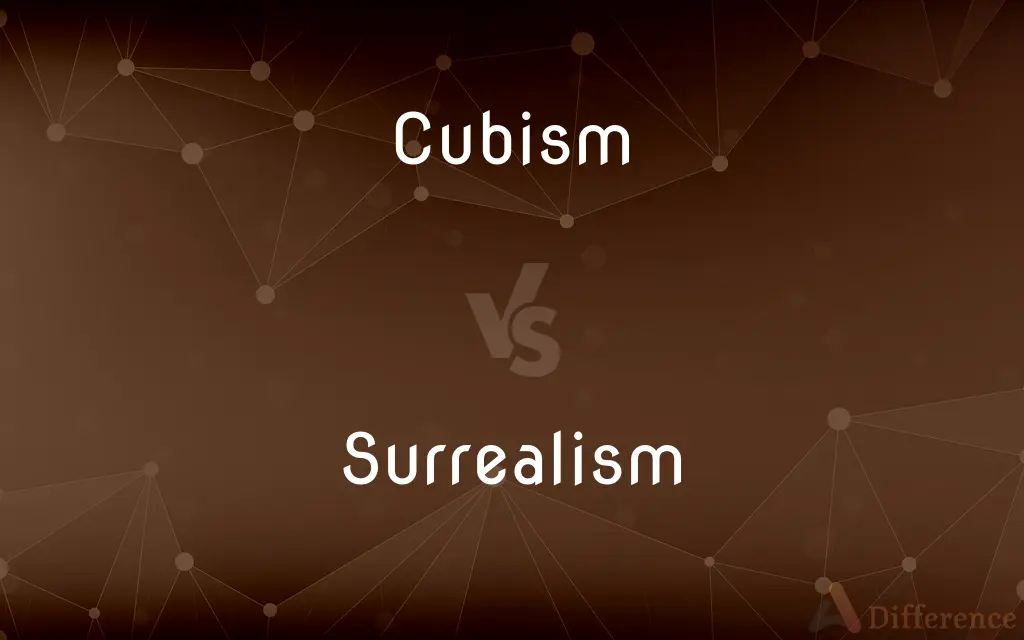Cubism vs. Surrealism — What's the Difference?
Edited by Tayyaba Rehman — By Fiza Rafique — Updated on April 9, 2024
Cubism breaks objects into geometric shapes, while Surrealism depicts dream-like scenes.

Difference Between Cubism and Surrealism
Table of Contents
ADVERTISEMENT
Key Differences
Cubism, initiated by artists like Pablo Picasso and Georges Braque, is characterized by the fragmentation of objects into geometric shapes, emphasizing the two-dimensional canvas space. Surrealism, influenced by Sigmund Freud's theories on the unconscious mind, seeks to reconcile the dream with reality, depicting bizarre, dream-like scenes that defy conventional logic.
While Cubism focuses on analyzing and reconstructing objects from multiple viewpoints to capture their essence in abstract form, Surrealism delves into the subconscious mind, expressing imaginative visions and uncanny juxtapositions. This contrast highlights Cubism's structural approach to object depiction versus Surrealism's exploration of the psyche.
Cubism often employs a limited color palette to accentuate its structural forms, reducing objects to cubes, cylinders, and other geometric shapes. On the other hand, Surrealism uses vivid colors and detailed imagery to evoke a sense of wonder, often incorporating elements of surprise and unexpected combinations.
The impact of Cubism lies in its revolutionary approach to visual representation, challenging traditional perspectives and leading to the development of abstract art. Surrealism’s impact, meanwhile, extends beyond art into literature and film, influencing the way narratives and imagery can explore the realms of the subconscious and the fantastical.
Cubism and Surrealism both contributed significantly to the modern art movement, yet their approaches and underlying philosophies present a study in contrasts: one grounded in the physical world's analytical deconstruction, the other in the limitless exploration of the human mind.
ADVERTISEMENT
Comparison Chart
Definition
An art movement emphasizing the fragmentation of objects into geometric shapes.
An artistic and literary movement that seeks to express the subconscious mind through dream-like scenes.
Key Artists
Pablo Picasso, Georges Braque
Salvador Dalí, René Magritte
Focus
Analyzing and reconstructing objects from multiple viewpoints.
Exploring the subconscious, dream states, and the irrational.
Techniques
Use of geometric shapes, limited color palette.
Vivid colors, detailed imagery, unexpected combinations.
Impact on Art
Led to abstract art, challenged traditional perspectives.
Influenced modern art, literature, and film with its exploration of the subconscious.
Philosophical Roots
Influenced by an interest in different perspectives and the essence of objects.
Inspired by Freudian psychoanalysis and the exploration of the human psyche.
Compare with Definitions
Cubism
Focuses on breaking down objects into geometric forms.
Picasso's Les Demoiselles d'Avignon deconstructs figures into angular shapes.
Surrealism
Explores dream states and the subconscious.
Dalí’s The Persistence of Memory features melting clocks in a dream-like landscape.
Cubism
Paved the way for various abstract movements.
Cubism's emphasis on form influenced movements like Futurism and Constructivism.
Surrealism
Draws on psychoanalytic theories of the subconscious.
Surrealist works often explore themes of desire, fear, and fantasy.
Cubism
Analyzes and reconstructs subjects from multiple viewpoints.
Braque’s landscapes explore multiple perspectives within a single canvas.
Surrealism
Combines disparate elements for shock and surprise.
Magritte’s The Son of Man presents an ordinary scene made strange by a floating apple.
Cubism
Often employs muted colors to emphasize structure.
Early Cubist works feature earth tones to highlight form over color.
Surrealism
Techniques aimed at bypassing conscious control to access creativity.
Automatic drawing and writing were used by Surrealists to tap into the subcons
Cubism
Seeks to depict the essence of objects beyond surface appearances.
Cubist still lifes dissect and reassemble objects in abstracted forms.
Surrealism
Extends beyond visual arts to literature and film.
Surrealism influenced writers like André Breton and filmmakers like Luis Buñuel.
Cubism
Cubism is an early-20th-century avant-garde art movement that revolutionized European painting and sculpture, and inspired related movements in music, literature and architecture. In Cubist artwork, objects are analyzed, broken up and reassembled in an abstracted form—instead of depicting objects from a single viewpoint, the artist depicts the subject from a multitude of viewpoints to represent the subject in a greater context.
Surrealism
Surrealism was a cultural movement which developed in Europe in the aftermath of World War I and was largely influenced by Dada. The movement is best known for its visual artworks and writings and the juxtaposition of distant realities to activate the unconscious mind through the imagery.
Cubism
A nonobjective school of painting and sculpture developed in Paris in the early 20th century, characterized by the reduction and fragmentation of natural forms into abstract, often geometric structures usually rendered as a set of discrete planes.
Surrealism
A literary and artistic movement of the 1900s that attempts to express the workings of the subconscious and is characterized by fantastic imagery and incongruous juxtaposition of subject matter.
Cubism
An artistic movement in the early 20th Century characterized by the depiction of natural forms as geometric structures of planes.
Surrealism
Literature or art produced in this style.
Cubism
A movement or phase in post-impressionism (which see, below).
Surrealism
An artistic movement and an aesthetic philosophy that aims for the liberation of the mind by emphasizing the critical and imaginative powers of the subconscious.
Cubism
An artistic movement in France beginning in 1907 that featured surfaces of geometrical planes
Surrealism
A 20th century movement of artists and writers (developing out of Dadaism) who used fantastic images and incongruous juxtapositions in order to represent unconscious thoughts and dreams
Common Curiosities
Can Surrealism be found in other forms of media?
Yes, Surrealism has influenced literature, film, and even psychology, with its exploration of dream states and the subconscious.
Who are key figures in the Cubist movement?
Pablo Picasso and Georges Braque are pivotal figures in Cubism.
How did Cubism influence the art world?
Cubism challenged traditional perspectives and led to the development of abstract art.
What techniques are associated with Cubism?
Cubism is known for its use of geometric shapes and a limited color palette to emphasize structure over detail.
How does Surrealism incorporate Freudian theories?
Surrealism draws on Freudian psychoanalysis to explore themes of desire, fear, and fantasy, often through symbolic imagery.
What is the main difference between Cubism and Surrealism?
Cubism breaks down reality into geometric shapes, while Surrealism explores the subconscious through dream-like scenes.
What characterizes Surrealist art?
Surrealist art is characterized by vivid, dream-like imagery that explores themes of the subconscious and irrational.
How do the color palettes of Cubism and Surrealism compare?
Cubism often uses muted, earthy tones to emphasize form, while Surrealism uses vivid colors to enhance its dream-like quality.
What is the significance of dreams in Surrealist art?
Dreams are central to Surrealism, serving as a bridge to the subconscious and a source of creative inspiration.
What impact did Surrealism have outside of visual arts?
Surrealism significantly influenced modern literature and cinema, introducing new narrative techniques and visual aesthetics.
How did Cubism and Surrealism view reality differently?
Cubism sought to depict reality through multiple perspectives and geometric abstraction, while Surrealism sought to reveal the hidden layers of the subconscious.
How did Cubist artists achieve a sense of depth?
Cubist artists created depth by overlapping and fragmenting objects from various angles, rather than traditional perspective techniques.
Did Cubism and Surrealism overlap in any artists’ works?
Some artists experimented with both movements, but each movement has distinct characteristics and philosophies.
What is automatism in Surrealism?
Automatism involves creating art without conscious thought, aiming to tap into the subconscious mind.
Why is Surrealism considered influential in psychological studies?
Surrealism's exploration of the subconscious and use of Freudian themes have provided insights into human psychology and creativity.
Share Your Discovery

Previous Comparison
Good vs. Goods
Next Comparison
Bucket vs. BowlAuthor Spotlight
Written by
Fiza RafiqueFiza Rafique is a skilled content writer at AskDifference.com, where she meticulously refines and enhances written pieces. Drawing from her vast editorial expertise, Fiza ensures clarity, accuracy, and precision in every article. Passionate about language, she continually seeks to elevate the quality of content for readers worldwide.
Edited by
Tayyaba RehmanTayyaba Rehman is a distinguished writer, currently serving as a primary contributor to askdifference.com. As a researcher in semantics and etymology, Tayyaba's passion for the complexity of languages and their distinctions has found a perfect home on the platform. Tayyaba delves into the intricacies of language, distinguishing between commonly confused words and phrases, thereby providing clarity for readers worldwide.
















































